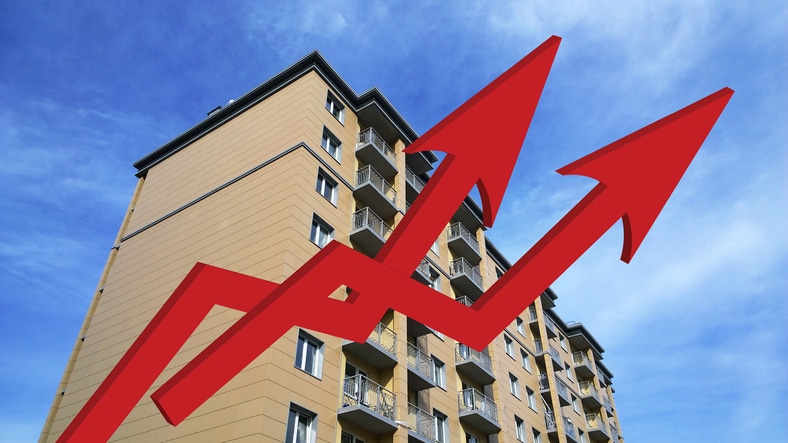Source: Curbed —
For a minute there, things looked grim for New York City landlords. The pandemic caused an exodus of such proportions that building owners were forced to cut rents to their lowest levels since the bad old days of 2011. But then a miracle happened. (Or at least one seemed to!) Not only did New York’s expats return; they came — in the eerily identical words of the real–estate industry and the credulous reporters who cover it — “flooding back.”
“What started as a trickle earlier last year has become like a geyser of demand,” exclaimed one broker in early 2022. Suddenly, there were lines around the block for open houses and bidding wars over unrenovated walk-ups. The vacancy rate in Manhattan fell below 2 percent, and median rent passed $4,000 for the first time. “I’m not exaggerating when I say that I’ve never seen the rental market as crazy as it is right now,” said another broker in July, right before prices went up again.
What could explain it? Even if all of New York’s deserters had soured on country living — like the publicist profiled by the New York Times who came crying back to Harlem after beavers flooded his yard in Saugerties — that still wouldn’t account for why there seemed to be fewer apartments available than before they’d left. Real-estate experts tried to identify factors that might be aggravating the shortage. Maybe the Fed was discouraging home sales with higher interest rates, so more people were renting. Or the couples that had split up during lockdown were separating and moving into all the one-bedrooms. Or single people had gotten claustrophobic and were spreading out into all the two-bedrooms. Or remote workers from other cities were coming to New York just because they felt like it.
Whatever the cause, the crunch left renters with two options: Pay through the nose or leave. Tenants who had scored pandemic discounts got renewal letters demanding double. Those seeking new places were advised to offer above asking price (i.e., “cuck money”) on apartments they hadn’t even seen in person but that nevertheless included outlandish broker fees and abased themselves accordingly. If they didn’t, they were told, plenty of other chumps would.
In other words, New York City — which in the first pandemic summer had been declared “dead forever” — was back! As long as you had not personally been ejected from your home, you might have even found it inspiring.
There was only one problem: None of it made any sense.
In late 2021 and early 2022, when demand for apartments was supposedly accelerating from trickle to geyser, New York was still besieged with COVID-related troubles. Return-to-office plans had been quashed by the Delta variant, then Omicron. Tourism was way down, and unemployment was twice the national rate. Crime was reportedly surging — people were getting shoved onto subway tracks — and outdoor dining had emboldened rats to live freely and openly among humans. Had all of the people who had presumably moved to escape these very concerns really come flooding back?
With every rise in the city’s median gross rents, my skepticism grew. I had lived happily in New York for more than two decades, through many disasters and rebounds, and I wanted to believe the story of its glorious post-COVID recovery. But why did it seem like all of the people telling it were also trying to lease me overpriced apartments?
I began to pick up faint dispatches from a distant, numbers-based reality, where a more plausible counternarrative was taking shape. “Manhattan Lost 6.9% of Its Population in 2021, the Most of Any Major U.S. County,” said a March 2022 headline. “NYC’s Population Plummeted During Peak COVID — And It’s Still Likely Shrinking,” said another from a couple months later. According to these stories, New Yorkers hadn’t come flooding back at all. In fact, they were probably still leaking out.
If that was the case, then the city’s rental frenzy defied not just laws of supply and demand but also conservation of mass. All of the people who fled the city over the past three years should have left behind a surplus of empty, habitable apartments. What happened to them? And why is it so difficult and expensive to lease one now?
The Exodus
While I am not technically a statistician, I do pay $7 a month for Microsoft Excel, and over the past year I’ve become somewhat obsessed with the U.S. Postal Service’s database of change-of-address requests, which tracks — across massive, laptop-choking spreadsheets — the number of people who forward their mail to and from every U.S. Zip Code each month. (Extracting just the data I wanted was a weeklong chore that involved filtering out all non-city Zip Codes including, most annoyingly, Nassau County’s, which are intermixed with those from Queens. But I think I got all of them.)
As you’d expect, USPS stats show that lots of New Yorkers skipped town during the pandemic. Between March 2020 and December 2021, there was a net loss of 317,107 permanent movers from across the five boroughs. In July 2020 alone, when moving companies were reportedly so busy they had to turn away customers, a net 25,439 movers left the city. Outbound migration has slowed since then, but it hasn’t changed direction. By my count, the city lost another 97,794 in 2022, ranging between about 6,000 and 11,000 per month.
But that’s not all, because New Yorkers were leaving before COVID. Change-of-address stats show there have been more departures than arrivals in every month since at least June 2017, the earliest month for which I was able to find data. Between then and December 2022, USPS data says 2,878,212 came to the city and 3,548,982 bailed, for a total net loss of 670,770.
Admittedly, change-of-address data is not a perfect gauge. Some business moves are sprinkled in. It captures moves to other countries but misses those to the city from abroad. (The Census Bureau estimates the city gained 33,818 international movers in 2019 but probably less in 2020 and 2021 owing to COVID-related travel bans. Last year saw the arrival of 40,000 asylum seekers.) It doesn’t track deaths (there were over 44,000 from COVID alone) or births (negligible for my purposes, since babies can’t rent apartments, at least not without guarantors). It can’t tell us how many movers within the city took up with roommates or got their own places. It doesn’t distinguish between renters and owners, although elevated outflows in summer months seem to imply many are leaving when their leases expire. And obviously it only includes people who remember to forward their mail, but we can probably assume movers are forgetful in both directions.
But while USPS data can’t give an exact count of how many people are in the city right now, it’s still a solid indicator for broad migration trends. It agrees directionally with the Census Bureau’s estimates, which show that the city’s population has been shrinking since 2016. And it correlates with other metrics such as declines in public- and private-school enrollments (down 9.5 and 3.6 percent, respectively, since 2019), subway ridership, and restaurant patronage.
If there had been any drastic surge in return traffic to New York in 2021 and 2022 — if all of those real-estate experts were telling the truth — it should’ve registered at least a blip in the USPS stats. After all, if so many movers had remembered to change their addresses on their way out, surely most of them would’ve remembered to change them on the way back, right? Instead, USPS data merely shows a gradual return to 2019-size losses.















